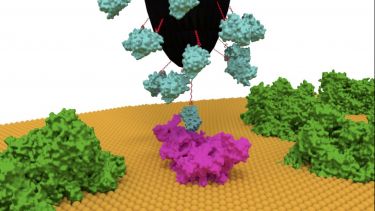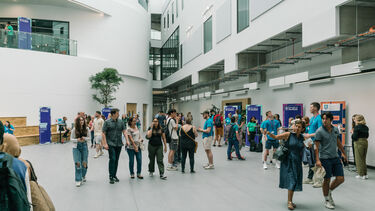The Sheffield Photosynthesis Group has been awarded a major new BBSRC grant worth £485K too study electron transfer reactions at the single-molecule level.
Electron transfer reactions are the basis of photosynthesis and respiration, which provide the energy source for all life on Earth. The energy directly provided by the sun or from foodstuffs is used to move electrons along a chain of proteins in order to release energy. Some of the proteins involved in the electron transfer chain can move freely back and forth carrying electrons to and from their partner proteins fixed within a thin sheet of biological membrane. The freely-moving electron carrier proteins have to pair with their appropriate membrane-attached partners quickly and specifically to ensure efficient electron transfer, while at the same time the pair has to be able to separate rapidly enough after the electron transfer process is complete so that the process can be repeated hundreds of times each second.
The new project will help to answer questions concerning the forces that direct and bring together the partner proteins; how do the electron carriers dock at the membrane surface and how they are released in a few microseconds after the electron transfer takes place? What is the switch that reverses the interactions between the proteins when they have to separate?
Traditionally, electron transfer reactions between proteins have been studied by looking at the optical properties of large ensembles. These proteins contain a coloured haem molecule, similar to haemoglobin in the blood, and the light-absorbing properties of the molecules change when electrons move between them. Monitoring the colour of the proteins, and therefore their cargo of electrons has shown how these proteins behave collectively.
In this new project, we aim to take a step further and to study the electron transfer reactions at the level of individual proteins. We have a significant gap in our knowledge regarding the attractive forces that bring these proteins together and the repelling forces that separate them after the electron has jumped between them. We do not know how the properties of the proteins or the surrounding environment affect the interactions between the molecules and how these factors affect the efficiency of the electron transfer process.
To measure the interaction forces and the actual electron transfer between the proteins, we developed a method to artificially bring the two electron transfer partners together. The protein that receives the electrons (the acceptor) is attached to a glass surface, while the protein that carries the electron(the donor) is attached to a very sharp tip of a probe that can be positioned very precisely in space. Bringing the probe to the surface-attached protein allows the electron to jump from the donor to the acceptor. This probe is part of a highly sensitive instrument called an atomic force microscope (AFM), which can also measure the current passing between the probe and the substrate.
When we retract the AFM probe from the surface we can measure the forces that resist the separation of the two proteins. At the same time, we can monitor how easy it is for the electron to jump between the proteins, by measuring the current between the probe and the surface.
With this experimental approach, we can use our AFM to find out how single protein molecules attract each other in the first place and how their interaction changes after electron transfer so that they can undock and separate. Moreover, we can use genetically-modified electron-accepting proteins and see how particular changes in the sites where the two proteins come into contact would affect the likelihood of the proteins docking together, and to find out how these changes would affect the efficiency of the electron transfer reactions and the subsequent uncoupling of the acceptor and donor protein partners.


